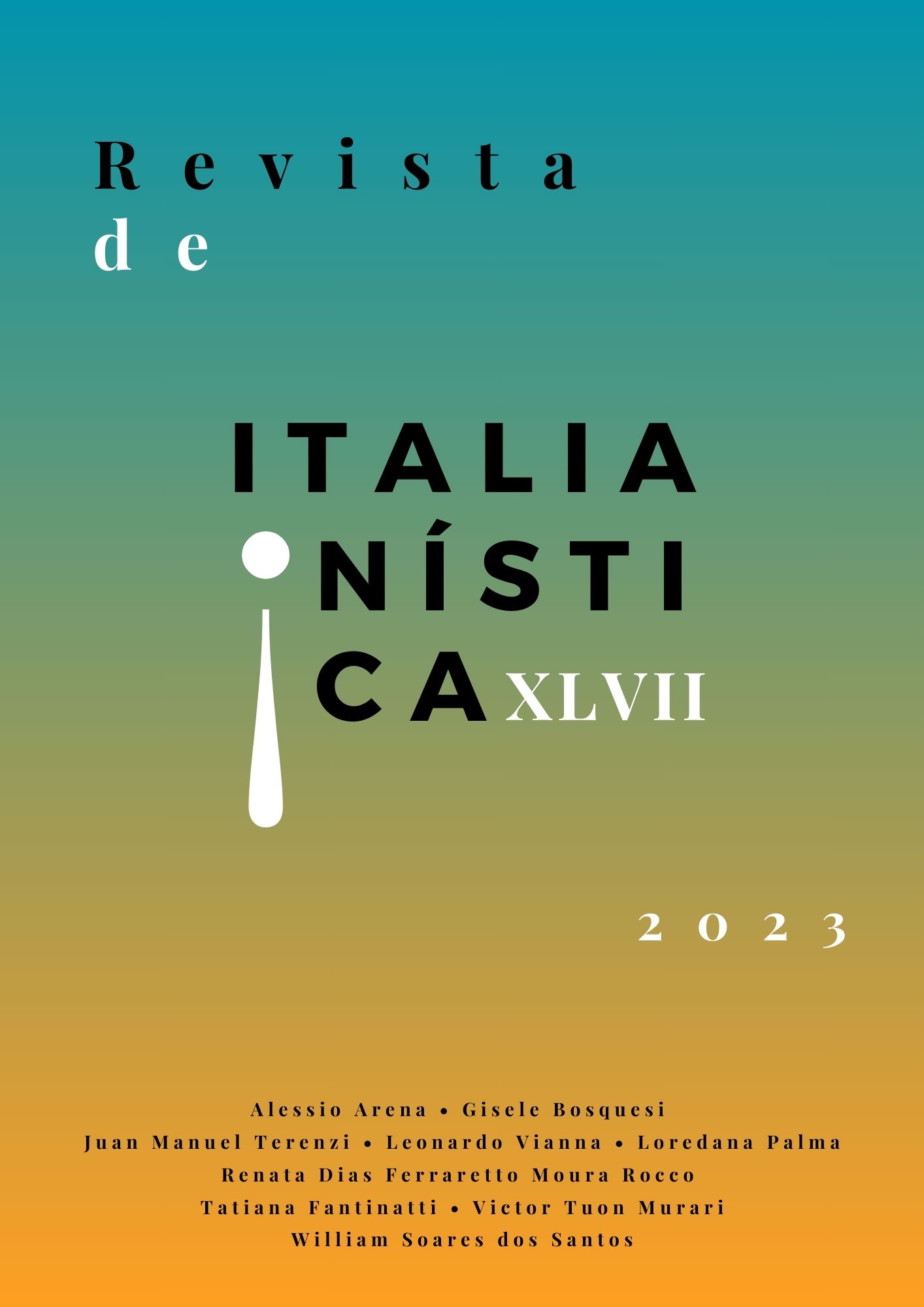Napoli è mille colori. La città brulicante: da Il paese di Cuccagna di Matilde Serao alla narrativa di Maurizio de Giovanni
DOI:
https://doi.org/10.11606/issn.2238-8281.i47p64-86Palavras-chave:
Nápoles, Paisagem, Pessoas, Serao, De GiovanniResumo
Entre as cidades mais frequentemente “atravessadas” pela literatura dos séculos XIX e XX, Nápoles ocupa um lugar importante. Descrito pelos seus filhos e por viajantes de passagem, em romances e reportagens, imortalizado em representações de vários tipos - desde as vistas de Pitloo a telas de Migliaro, da fotografia à cinematografia (de Il sindaco del rione Sanità de Mario Martone), ao último Sorrentino em It was the Hand of God, através de dois “estrangeiros"ì” como Turturro e Ozpetek, directores de Passione e Napoli velata respectivamente), Nápoles é descrita de mil maneiras diferentes, mas nunca de forma asséptica. Dois elementos essenciais nunca faltam na história da cidade: o olhar do observador e o elemento humano, que é uma parte integrante da paisagem. Evocada mesmo na música (de Marechiare a Napul’è de Pino Daniele), a cidade permanece um mistério inefável para os seus próprios habitantes e a sua visão é refractada em mil imagens, do preto e branco à cor, cada uma das quais contendo um pedaço de verdade. A contemplação extasiante, de cima, do Golfo e do Vesúvio, é contrastada em baixo, tanto na escrita como nas representações visuais, com becos escuros, ruas cheias de vida, amor e dor, esperança e resignação, luxo e miséria. Este será o caminho que nos conduzirá, do século XIX ao século XXI, da tumultuosa cidade de Matilde Serao’s Paese di Cuccagna até à igualmente animada cidade de Maurizio de Giovanni, sem que Nápoles tenha perdido a sua capacidade de surpreender e de ser contada nos seus milhares de cores diferentes.
Downloads
Referências
DE GIOVANNI, M., I bastardi di Pizzofalcone, Torino, Einaudi, 2013.
DE GIOVANNI, M., La condanna del sangue. La primavera del commissario Ricciardi [2008], Torino, Einaudi, 2012b.
DE GIOVANNI M., Per mano mia. Il Natale del commissario Ricciardi, Torino, Einaudi, 2011.
DE GIOVANNI, M., Il senso del dolore. L’inverno del commissario Ricciardi [2007], Torino, Einaudi, 2012a.
MASTRIANI, F., Il mio cadavere, Napoli, Omnibus, 1852.
SAVIANO, R., Gomorra. Viaggio nell'impero economico e nel sogno di dominio della camorra, Milano, Mondadori, 2006.
SERAO, M., All’erta, Sentinella! Terno secco-Trenta per cento-O Giovannino o la morte. Racconti napoletani, Milano, Baldini & Castoldi, 1904.
SERAO, M., Il paese di Cuccagna. Romanzo napoletano [1889-1891], De Caprio, C. (a cura di), Napoli, Partagées, 2004.
SERAO, M., Il romanzo della fanciulla, Milano, Treves, 1886.
SERAO, M., Il ventre di Napoli, Milano, Treves, 1884.
PUBBLICAZIONI ONLINE:
CATÀ C., "Non ti disunire". Mistero e grandezza della battuta cult di Sorrentino. In: HuffPost Italia. Disponibile a: "Non ti disunire". Mistero e grandezza della battuta cult di Sorrentino - HuffPost Italia (huffingtonpost.it). Access in: 23 apr. 2022.
FILM E MATERIALE ICONOGRAFICO:
Film:
DE SICA, V. Il Giudizio Universale, Francia e Italia, De Laurentiis, 1961, 98’
GARRONE, M. Gomorra, Italia, Fandango, 2008, 137’.
LOY, N. Mi manda Picone, Italia, Medusa, 1983, 120’.
MARTONE, M. Il sindaco del rione Sanità, Italia, Indigo film, 2019, 115’.
MARTONE, M. Qui rido io, Italia e Spagna, Indigo film, 2021, 133’.
OZPETEK, F., Napoli velata, Italia, Warner Bros Italia, 2017, 113’.
RUBINI, S. I fratelli De Filippo, Italia, Rai Cinema, 2021, 139’.
SORRENTINO, P. È stata la mano di Dio, Italia, The Apartment,130’.
SORRENTINO, P. La grande bellezza, Italia e Francia, Indigo film, 2013, 143’.
TURTURRO, J. Passione, Italia e Stati Uniti, Skydancer, 2010, 90’.
Televisione:
ARISTARCO, T. (regista). Mina Settembre (serie televisiva), Italia, Rai Fiction, 2021.
CARLEI, C. – D’ALATRI, A. – VULLO, M. (registi). I bastardi di Pizzofalcone (serie televisiva – 3 stagioni), Italia, Rai Fiction, 2017-2021.
CIPOLLITTI, G. (regista), Ulisse: Il piacere della scoperta. I mille segreti di Napoli, Italia, Rai, 2015.
CIPOLLITTI, G. (regista). Meraviglie – La penisola dei tesori [puntata su Napoli], Italia, Rai, 2022.
CIPOLLITTI, G. (regista). Stanotte a Napoli, Italia, Rai, 2021.
COSTANZO, S. – ROHRWACHER, A. – LUCHETTI, D. L’amica geniale (serie televisiva – 3 stagioni), Italia e Stati Uniti, Fandango e Wildside, 2018-2022.
D’ALATRI, A. – TESCARI, G. (registi). Il commissario Ricciardi (serie televisiva), Italia, Rai Fiction, 2021.
PELLEGRINI, L. (regista). Carosello Carosone (film TV), Italia, Rai Fiction, 2021.
SOLLIMA, S. – COMENCINI, F. – CUPELLINI, C. – GIOVANNESI, C. – D’AMORE, M. (registi). Gomorra (serie televisiva 5 stagioni), Italia, Sky – Cattleya – Fandango, 2014-2021.
Sculture:
SAMMARTINO, G. Cristo velato, 1753, marmo [collocazione: Cappella Sansevero, Napoli].
Dischi:
Campi Flegrei. BENNATO, E., Ricordi, 1973, vinile, 4:19.
Marechiare. DI GIACOMO, S. e TOSTI, F. P., 1886.
Munasterio ’e Santa Chiara. GALDIERI, M. e BARBERIS, A., 1945.
Napul’è. DANIELE, P., EMI, 1977, CD, vinile, 3:47.
Nisida. BENNATO, E., Ricordi, 1982, vinile, 5:15.
’O paese d’’o sole. D’ANNIBALE, V. e BOVIO, L., 1925.
Pusilleco addiruso. MUROLO, E. e GAMBARDELLA, S., Bideri, 1904.
Santa Lucia luntana. MARIO, E. A., 1919.
Torna a Surriento. DE CURTIS, E. e DE CURTIS, G., 1894.
Tu ca nun chiagne. DE CURTIS, E. e BOVIO, L., La Canzonetta, 1915.
Downloads
Publicado
Edição
Seção
Licença
Copyright (c) 2023 Revista de Italianística

Este trabalho está licenciado sob uma licença Creative Commons Attribution-NonCommercial-NoDerivatives 4.0 International License.
A revista retém os direitos patrimoniais dos artigos e os publica simultâneamente sob uma Licença Creative Commons-Atribuição-Não Comercial-Sem Derivações.











